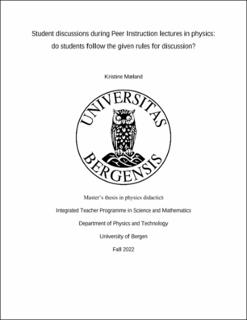| dc.description.abstract | In modern physics education, Peer Instruction has been established as an excellent method of effectively engaging students in the course material. In Peer Instruction lectures, students are introduced to a conceptual multiple-choice question. The students first try to solve the question with individual thinking, and either write down their answer or show it to the lecturer when prompted. Then they discuss their answer with their neighbor, trying to explain their ideas during group discussions. Again, the students write down the answer, and/or reveal it to the lecturer. During these group discussions, the students engage in Peer Instruction. A potential weakness of active learning, such as Peer Instruction, is its dependency on the participating students: Low engagement from a few students can negatively affect the rest of the group. Having the entire group participate is thus essential. One way to promote participation and good discussions is to provide rules for these discussions. The given rules should encourage students to participate, explain their answers, address each other’s ideas, elaborate on physical principles and concepts, as well as seek agreement on the given problem. These rules, along with two others, are the basis for the research presented in this thesis. Following a physics introductory class and recording the discussions between students during Peer Instruction, this thesis investigates whether the students follow rules for discussion when given explicit rules to follow. This poses the research question: Do the students follow the rules for discussion given by the lecturer? The findings in this thesis indicate that the students follow some of the rules for discussion, but not all of them. Lack of participation, or exclusion from participation, even prevented good discussion in some cases that were highlighted. Though the students in the study showed a strong understanding of the relevant concepts, and used principles and terminology to explain their ideas, they also showed poor communication skills, and this naturally affected the group discussion. I conclude this thesis by suggesting that the potential implications from these findings could be: (a) Peer Instruction may be most effective in smaller groups consisting of either two or three students. (b) Practicing methods of “talking in turns” in the discussions could ensure every student in a group gets to contribute to and participate in the discussion. (c) Selecting fewer rules for discussion when preparing for Peer Instruction. | |
